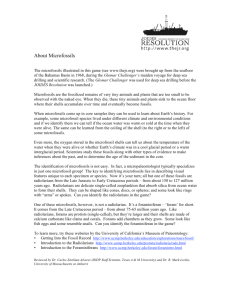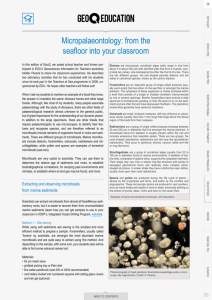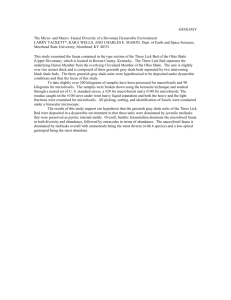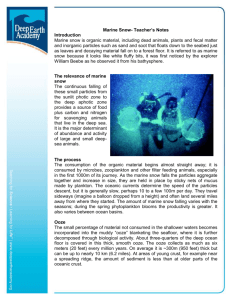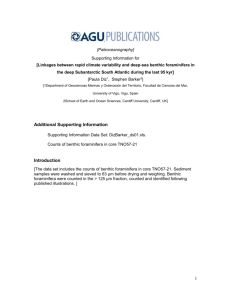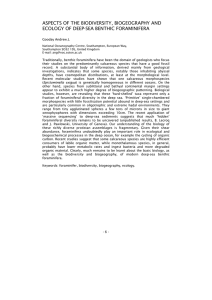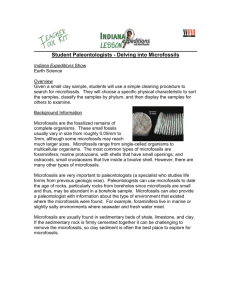Marine Microfossils Dr. J Bret Bennington Department of Geology
advertisement
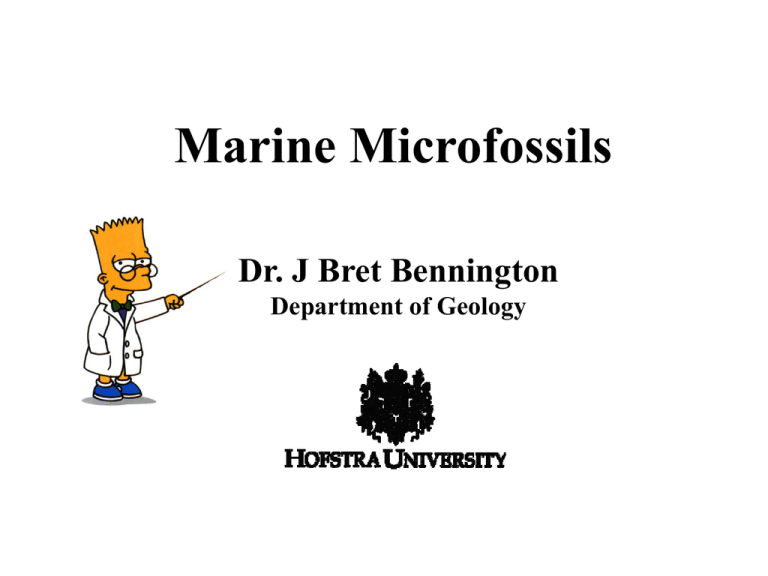
Marine Microfossils Dr. J Bret Bennington Department of Geology What are marine microfossils? • Fossilized remains of small organisms or tiny hardparts of larger organisms. • Plankton • Benthic fauna • Many different groups representing animals, protists, and a variety of algae. Protistan Microfossils • Mineralized test (shell) formed by amoebalike protozoans. • Foraminifera - calcareous (calcium carbonate) or agglutinated (test composed of cemented grains of sand or other sediment). • Radiolaria - test composed of silica. Foraminifera - sarcodina (amoeba) Protistan Microfossils Foraminifera - sarcodina (amoeba) Benthic forams • live in sediments • relatively large Planktic forams • live floating in the water column • relatively small Protistan Microfossils Foraminifera - sarcodina (amoeba) Benthic forams Protistan Microfossils Calcite Foraminifera Planktic forams Calcite Protistan Microfossils Radiolarians - Spumellarians Protistan Microfossils Silica Radiolarians - Nacellarians Protistan Microfossils Silica Animal Microfossils • Mineralized shells and teeth produced by metazoans (multicellular animals). • Ostracods - calcareous (calcium carbonate) shell produced by tiny crustaceans. • Conodonts - calcium phosphate “teeth” produced by an extinct group of vermiform (worm-like) vertebrates. Ostracods - Arthropoda Animal Microfossils calcite Conodonts - Vertebrata Animal Microfossils Conodonts - Vertebrata conodont apparatus Animal Microfossils Conodonts - Vertebrata Animal Microfossils Conodonts - Vertebrata microwear facets Animal Microfossils calcium phosphate Algal Microfossils • Mineralized tests and plates produced by a variety of unicellular algae. • Coccolithophorids - tiny algae that produce calcareous plates - main component of chalk. • Diatoms - algal cells that produce paired tests (called frustules) composed of silica. • Dinoflagellates - marine algae that produce organic cysts preserved in sedimentary rock. Also the cause of most harmful algal blooms (HABs). Coccolithophorids - Haptophyta Algal Microfossils calcite Chalk Cliffs, England Diatoms - Chrysophyta Pennate - benthic, parasitic Algal Microfossils silica Centric - planktic Diatoms - Chrysophyta silica frustules Algal Microfossils Diatoms - Chrysophyta Algal Microfossils silica Dinoflagellates - Pyrrhophyta living Algal Microfossils Sporopollenin fossil Dinoflagellates - Pyrrhophyta Living cell Cyst Why are marine microfossils useful? • Biostratigraphy - dating rock layers using fossils. • Environmental reconstruction - identifying different marine environments in the past. • Paleothermometry - determining ocean water temperature in the past. • Paleoclimatology - reconstructing climate change through Earth’s history. From Sugarman, et. al, 1995 Biostratigraphic zones - intervals of time defined by the presence of particular fossil species. From Sugarman, et. al, 1995 Coccoliths From Sugarman, et. al, 1995 Foraminifera Deep Sea Drilling Project ship - Glomar Challenger Recovering sediment cores from the deep ocean. Foraminifera • Fossil foram species can be used to date age of seafloor and sediment layers. Stable Isotopes Oxygen O16 O18 99.76% .2% CO2 + H2O = HCO3-1 + H+ 2 HCO3-1 + Ca++ = CaCO3 + H2CO3 • O18 is preferentially removed from seawater during calcite formation. • This effect is sensitive to temperature. • Ratio of O18 / O16 in shell is temperature dependent. • Can be measured using a mass spectrometer. Mass Spectrometer Increasing 18O in calcite relative to water Change in isotopic ratio in carbonate shell with change in water temperature. Modern sea-surface temperature d18O due to ice buildup less ice Glaciations cause more d18O to accumulate in seawater. This happens because 16O evaporates preferentially and becomes trapped on land as glacial ice. negative excursion H216O more ice positive excursion Average d18O curve from 5 deep sea cores (foram calcite). warming After Imbrie et al. (1984) cooling Onset of Cenozoic cooling trend development of cold deep ocean circulation. Navesink Formation, central New Jersey 70X Benthic foraminifera 70X Benthic foraminifera Planktic foraminifera 70X 70X Ostracod 70X Ostracod valve 70X Burrowing echinoid spine 70X Fish denticle
